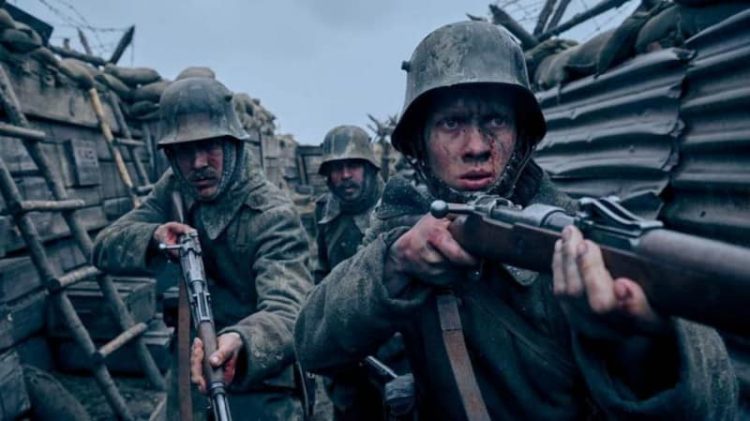The newest adaptation of Erich Maria Remarque’s acclaimed 1929 novel sees war at its most chilling.
Netflix
By Aurora Amidon · Published on October 29th, 2022
The moment we meet the protagonist of All Quiet on the Western Front, a seventeen-year-old, doe-eyed and bushy-tailed student named Paul Bäumer (Felix Kammerer) who lies about his age to enlist in the first World War, we know that he is doomed. Director Edward Berger ensures we don’t forget this fact,
opening the film with dread-inducing pans of the colossal soon-to-be European war fronts and accompanying Paul and his comrades’ hopeful pre-war moments with Volker Bertelmann’s foreboding ticking time bomb of a score.
The film, adapted from German soldier Erich Maria Remarque’s acclaimed 1929 novel of the same name based on his own chilling experiences, starts in 1916 when thousands of young soldiers still had a romantic attitude toward the possibility of becoming heroes.
Paul and his comrades quickly become disillusioned with the prospect of war, however, when they are flung into the cold, perilous frontline trenches with little to protect them but their own wits. Soon after bleak wartime realities set in for the young soldiers, Berger jumps forward three years to the tail end of the war, where the majority of All Quiet takes place. During this time, German diplomat Matthias Erzberger (Daniel Brühl) is racing against the clock to put an end to the atrocities, and Paul and his friends have given up most hope that the nightmare will ever end.
Matthias’s efforts provide the story with a welcome dose of purpose and suspense, but All Quiet’s strengths really lie in portions that are not necessarily guided by a story or a clear objective. Indeed, more thought-provoking than anything going on behind the scenes is simply Paul trudging through countless battles that are largely uniform in sound design, pacing, and look – a sameness that tells us more about the aching mundanity and futility of war than a leader refusing to sign a peace treaty ever could.
Also illuminating are scenes that feature the soldiers going about their day-to-day lives: stealing chickens from nearby farms for meals, reading letters from loved ones, and wistfully discussing the delightful blandness of their lives prior to 1916. These scenes never fail to highlight the soldiers’ humanity, thus making the unavoidable battle scenes that much more devastating.
And devastating they are. After so painstakingly drawing out his characters’ humanities with the help of co-screenwriters Lesley Paterson and Ian Stokell, Berger is aware that to shy away from the atrocities they faced would be a disservice. Using staggeringly realistic practical effects, he is not afraid to let a soldier’s death play out in full or linger for a little too long on a disquieting birds-eye shot of a mass battlefield grave.
Of course, Berger’s authentic portrait of the realities of combat wouldn’t be half as harrowing without a stellar cast. Kammerer is a flawless protagonist, wearing the blunt force of Paul’s deteriorating morale in his blistering blue eyes and conveying a creeping sense of chagrin in his increasingly gloomy demeanor, which he portrays in his slumped shoulders, feeble voice, and a weary, blank expression that he wears during the most ferocious of battle scenes.
Albrecht Schuch also shines as Stanislaus “Kat” Katczinsky, Paul’s best friend and fellow soldier. Likely the most complex character in All Quiet, he is an illiterate shoemaker who struggles with conflicting feelings about the obvious hardships of war and the sometimes pleasant simplicity of it all. Schuch plays Kat with a quiet sense of mystery and a demeanor that suggests he is always thinking much more than he says.
Most of All Quiet is difficult to watch – both because of its close-up portrayals of the brutalities of war and because anyone who recalls their high school history class knows that the death statistics over these couple of years were staggering. One can’t help but acknowledge that if it isn’t our once-soulful protagonist who dies a tragic, lonely, and untimely death, then it’s millions of others just like him.
Still, the film never feels dreary. Every scene is intentional and dynamic, with editor Sven Budelmann teasing out each storyline to the limit of its suspense right before cutting to another one. Through this, he easily keeps the audience’s interest peaked throughout the film’s nearly two-and-a-half-hour runtime.
But most impressive of all is that All Quiet feels utterly timeless. Indeed, it’s been some time since the heart-wrenching realities of senseless violence have been portrayed with such honesty. It’s hard to believe these events took place hundreds of years ago and not yesterday.
All Quiet on the Western Front begins streaming on Netflix on October 28. Watch the film’s trailer here.
Related Topics: Netflix

Aurora Amidon spends her days running the Great Expectations column and trying to convince people that Hostel II is one of the best movies of all time. Read her mostly embarrassing tweets here: @aurora_amidon.
Recommended Reading
Source by filmschoolrejects.com


